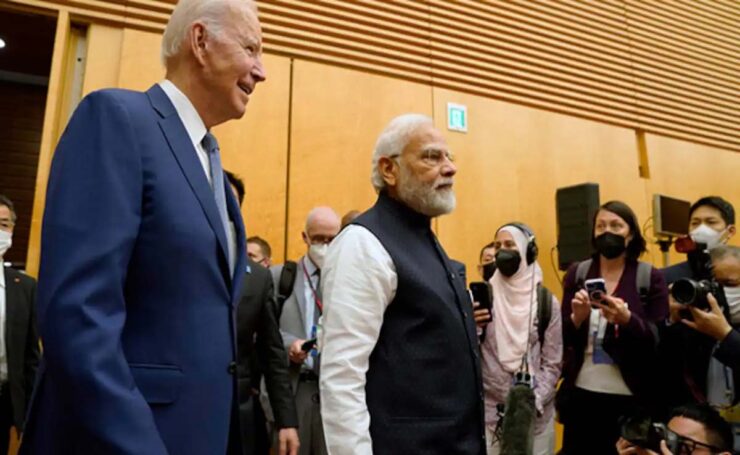
In the run-up to Prime Minister Modi’s state visit to the US on Wednesday, June 21, 2023, US business leaders are excited over prospects of deeper Indo-US technological convergence in such sectors as semiconductors, cyber security, telecom, 5G and 6G, and defence.
On Tuesday, June 13, 2023, addressing a gathering of top American corporate leadership at the annual India Ideas Summit ahead of Modi’s visit, US-India Business Council (USIBC) president Atul Keshap said American companies support India’s ambitions and align with its national interests. The summit was the largest gathering of Indian and US CEOs, before the State Visit. He said the plan was to raise the quantum of trade as rapidly as possible to USD 500 billion.
“I’d like to see more defence deals. Defence deals are really important for deterrence. When we host Indus X next week, we’re gonna try to see how that startup incubator of ideas and convergence can have even more impact on the US-India relations,” Keshap said.
A Visit Like Never Before: Modi has been a frequent visitor to the US, with roughly one trip each year since he took on the mantle of prime ministership in 2014. But this is his first-ever State Visit, pivoting on a ceremonial reception and banquet at the White House on June 22 and hemmed in by other marquee events on June 21 and 23.
On June 22, President Joe Biden and First Lady Jill Biden will welcome Modi as a State Guest in Washington DC. Modi will address a joint session of the US Congress—the US House of Representatives and Senate—on that day. This is one of the highest honours that Washington bestows on foreign dignitaries. President Biden and the First Lady will also host a State Dinner for Modi later on the same day.
This visit is significant as none of his earlier visits to the US were classified as a ‘State Visit’. President Biden will be Modi’s host on this visit and the Indian Prime Minister will be put up in a room for four days/three nights at the President’s official guesthouse, Blair House, which is within walking distance of the White House.
Speaking at the annual India Ideas Summit of the US-India Business Council, US Commerce Secretary Gina Raimondo said Prime Minister Narendra Modi’s State Visit to the US would present an opportunity for taking Indo-US commercial and strategic technology partnership to the next level, Raimondo said, “This will be an opportunity to elevate our governments’ commercial and strategic technology partnerships, including in defence, semiconductor supply chains, clean energy and space.”
Elaborating further, Raimondo—a great proponent of Indo-US ties—said she and Union Commerce and Industries Minister Piyush Goyal were concentrating on the development and security of critical and emerging technology. Semiconductors were a critical element of this effort and the memorandum of understanding (MoU) that was signed by Minister Goyal and her in March this year would bring the two nations closer as both respond to the urgent need to create stronger and more secure semiconductor supply chains,” she said.
During the business deliberations, the two countries also announced that a new working group would draw upon the strengths of the two countries’ vigorous and thriving trade and investment ties and a shared vision of entrepreneurship to promote innovation and create jobs—especially in the field of emerging technologies. Raimondo said the two countries were planning to bolster and connect their respective dynamic innovation ecosystems, address regulatory hurdles to cooperate and further strengthen the mutual vision of taking the strategic technology partnership between the two countries to the next level.
Raimondo said that the US was collaborating with India as part of the Indo-Pacific Economic Framework (IPEF). She said it was the US Administration’s overarching framework for deepening economic cooperation in the Indo-Pacific. Last month, the US announced that the first-of-its-kind international pact on supply chains had been substantially concluded. The proposed agreement made it incumbent upon the IPEF partners to seek ways and means to strengthen the resilience, security and diversity of mutual supply chains through individual and collaborative actions, she added.
Keshap told PTI on the sidelines of the summit that Modi’s State Visit o Washington, DC, next week was going to be a watershed event. The business community and, certainly, the government was very keenly looking forward to the visit… very keenly looking forward to how cooperation in various areas and functions could be stepped up, he added.
US National Security Adviser Jake Sullivan arrived in India and held talks with his counterpart, Ajit Doval, on a roadmap for bilateral collaboration in seven hi-tech areas and firmed up the ‘deliverables’ in the backdrop of Modi’s Washington visit. The roadmap formed part of the agenda at the second 1.5-track dialogue on the Initiative on Critical and Emerging Technologies (iCET) organised by the Confederation of Indian Industry (CII), which both Sullivan and Doval attended.
The seven sectors identified under the roadmap are: semiconductors, next-generation telecommunications, artificial intelligence, defence, space, biotechnology and advanced materials. These, according to the US, are priority areas for the US’s plan to ‘decouple’ or ‘derisk’ itself from China with relations between the two superpowers getting increasingly sour.
–The author of this article is a Defence, Aerospace & Political analyst.








